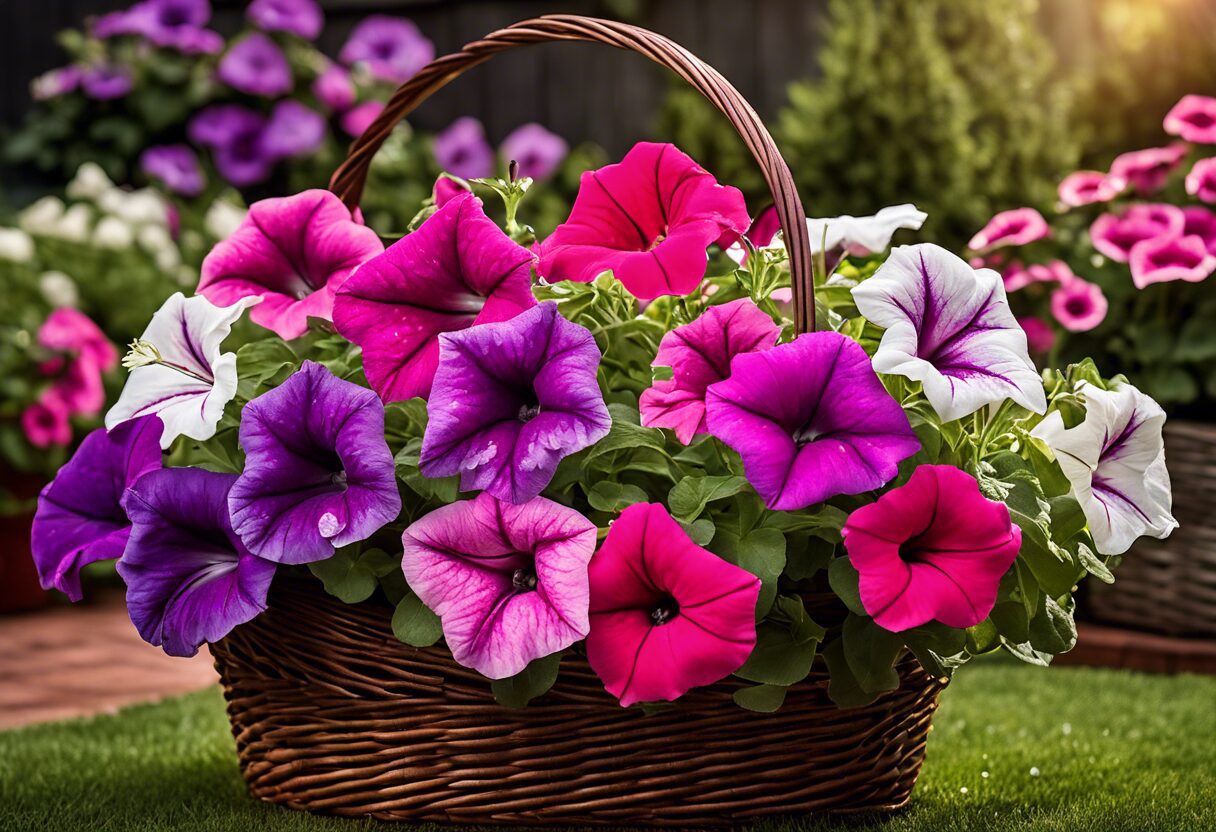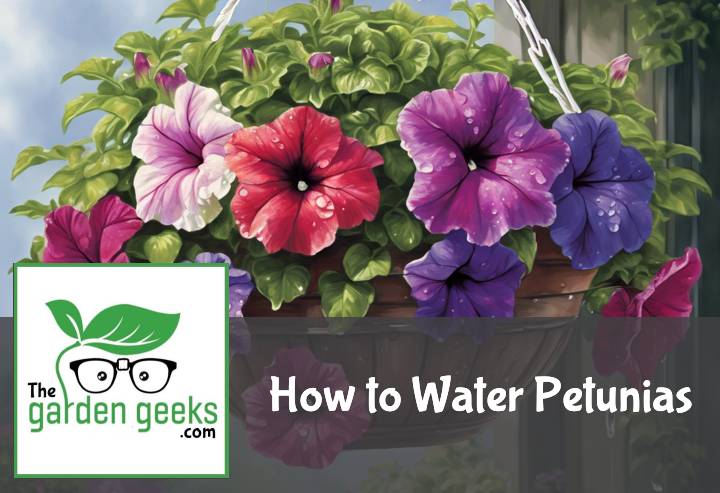Ever found yourself staring at your petunias, watering can in hand, wondering just how much H2O these beauties need? Well, you’re not alone. Trust me, I’ve been there too! That’s why I decided to create this guide on How to Water Petunias.
In the next few lines, we’ll dive into the world of petunias and their thirst-quenching needs. So grab your gardening gloves and let’s get started! Keep reading about How to Water Petunias.
Key Takeaways
- Petunias require regular watering, ideally in the morning to prevent fungal diseases.
- The soil should be kept moist but not waterlogged. Overwatering can lead to root rot.
- In hot weather, petunias may need daily watering. In cooler climates, watering every other day or twice a week may suffice.
- Use a soaker hose or drip irrigation system for efficient watering and to avoid wetting the foliage.
- Adjust your watering schedule based on rainfall and season changes.

Understanding Petunias
Petunias, those vibrant, trumpet-shaped flowers that bring so much joy to our gardens. They’re more than just a pretty face though. Proper petunia care, especially when it comes to watering, is essential for their growth and overall health.
What are Petunias?
So, what exactly are petunias? Well, they’re a genus of flowering plants originating from South America. Known for their bright colors and lovely fragrance, petunias have become a popular choice among gardeners worldwide. The definition of petunias can be summed up as hardy, annual plants that bloom from spring until frost.
Their origin is quite fascinating too! These beauties were discovered in the wilds of Argentina back in the 18th century. Over time, they’ve been cultivated into the stunning varieties we see today.
As for their characteristics, petunias come in an array of colors and sizes. From petite dwarf varieties to grand trailing ones, there’s a petunia for every garden!
Different Types of Petunias
Speaking of variety, let’s delve into the different varieties of petunias out there. First off, we have the Grandiflora petunias – these guys are known for their large flowers and dramatic flair.
Next up are Multiflora petunias which boast smaller but more abundant blooms. If you’re after something a bit different, then Milliflora petunias might be your cup of tea with their miniature flowers.
And lastly, we’ve got Spreading or Wave petunias – these bad boys spread like wildfire and make excellent ground cover! Each type has its own charm and appeal making them all popular petunia species among gardening enthusiasts.
Why Proper Watering is Crucial for Petunias?
Now onto the juicy stuff – watering. You might be wondering, why is watering so important for these little guys? Well, like all living things, petunias need water to survive and thrive.
Proper watering is crucial for petunia health as it helps the plant absorb nutrients from the soil. It also keeps the plant hydrated and aids in photosynthesis.
On the flip side, improper watering can lead to a host of problems like root rot and wilting. So remember folks, when it comes to how to water petunias, it’s not just about quantity but quality too!
When to Water Petunias?


Now, let’s get down to the nitty-gritty of how to water petunias. Timing is everything, folks! It’s not just about watering them; it’s about when you do it.
Identifying the Right Time of Day
So, what’s the best time to water your petunias? Early morning or late evening are your best bets. Why so? Well, watering in the morning gives your petunias a good start for the day. They’ll have all the hydration they need before that big ol’ sun starts beating down on them.
But hey, if you’re not an early bird, don’t sweat it! Evening watering works too. Just make sure it’s done before nightfall so your petunias aren’t left sitting in cold water overnight. That’s a no-no in petunia care routine.
Remember, finding that optimal watering time for flowers can be a game-changer for your petunias’ health and growth. So keep an eye on that clock!
Recognizing Signs of Thirst in Your Petunias
Alrighty then, how do we know when our petunias are thirsty? Well, they won’t exactly start panting or anything (they’re plants after all), but there are signs you can look out for.
First off, check their leaves. If they’re wilting or turning yellowish-brown, those are clear signs of thirsty flowers. Also look out for droopy stems and slow growth – these could mean your petunia is dehydrated.
On the flip side though, overwatering ain’t good either! If you notice soft and mushy stems or leaves turning yellow from the bottom up – yep you guessed it – you might be giving them too much H2O!
| Condition | Watering Frequency | Details |
|---|---|---|
| Soil Moisture | When the top 1-2 inches of soil are dry | Check the soil moisture by sticking your finger into the soil. Water if the top 1-2 inches are dry. |
| Weather Conditions | Varies with weather | Water more frequently during hot, dry spells and less during cool, cloudy, or humid conditions. |
| Time of Day | Early morning or late evening | Watering during these times reduces evaporation and allows water to soak deeply into the soil. |
| Plant Size and Age | Young plants more frequently | Newly planted or young Petunias may need more frequent watering to establish roots, compared to mature plants. |
| Container vs. Ground | Containers: Daily or every other day; Ground: Less often | Potted Petunias dry out faster and may require more frequent watering than those planted in the ground. |
| Season | More in summer, less in spring/fall | Adjust watering frequency according to the season and temperature. |
| After Fertilizing | Maintain regular watering schedule | Ensure soil is moist before and after fertilizing to prevent root burn and promote nutrient absorption. |



How Much Water Do Petunias Need?
When it comes to petunia care, one of the key factors is understanding how much to water petunias. The amount of hydration these beauties need can vary depending on a couple of things. We’re talking about the size of your plant and the weather conditions.
Determining the Amount of Water Based on Plant Size
Let’s start with petunia size and water needs. You see, small petunias are like tiny sponges, they don’t require a lot of water. So when you’re watering small petunias, think little and often.
On the flip side, larger petunias have more roots that need quenching. Hence, watering large petunias requires a bit more H2O. But remember, overwatering is a big no-no in petunia care!
So keep in mind that different sized plants have different water needs for different sized petunias.
Adjusting Water Quantity Based on Weather Conditions
Now let’s talk about how Mother Nature plays her part in this whole watering business. If you live somewhere where it’s hotter than a jalapeno pepper most days (petunias in dry weather), your thirsty plants will need more water.
But if you’re dealing with wetter conditions (watering petunias in wet weather), then ease up on the watering can! Too much water can lead to root rot and other nasty stuff.
In short, always be mindful of adjusting your watering routine based on the current climate conditions because it has a significant impact on how to water petunias.
Techniques for Watering Petunias
When it comes to how to water petunias, there’s more than one way to skin a cat, or in this case, water a flower. We’ve got your traditional methods like the good ol’ garden hose and sprinkler system. But then we also have the fancy stuff like soaker hoses and drip irrigation systems. Each method has its own perks, so let’s dive right in!
Using a Garden Hose or Sprinkler System
Watering petunias with a garden hose is as simple as it sounds. You just aim, spray, and watch those flowers drink up! But remember folks, these are petunias we’re talking about here. They’re not exactly camels now, are they? So don’t go flooding them with water.
Now if you’re using a sprinkler system, it’s pretty much the same deal. The only difference is you get to sit back and relax while your sprinklers do all the work. Just make sure you’re not accidentally creating a mini Niagara Falls for your petunias.
Preventing overwatering is key here. Too much of anything can be bad, even water! And trust me, you don’t want to see what happens when petunias get too much water. It ain’t pretty.
Avoiding damage when watering is also crucial. Remember that scene from Jaws where the shark jumps out of the water? Yeah, that’s what high pressure water feels like to your petunias.
The Benefits of Soaker Hoses and Drip Irrigation Systems
Now let’s talk about soaker hoses and drip irrigation systems – the Ferraris of petunia watering techniques.
Soaker hoses are great because they deliver water directly to where it’s needed most – the roots! This means less wasted water and happier petunias. Plus, they’re super easy to use. Just lay them out, turn on the water, and let them do their thing.
Drip irrigation systems are another fantastic option for watering petunias. They’re efficient, effective, and they make your garden look like it’s got its own personal rain cloud. How cool is that?
Both these methods allow for slow and steady watering, which is just what petunias need. It’s like they say – slow and steady wins the race! Or in this case, grows the best petunias.
Common Mistakes While Watering Petunias
Alrighty then, let’s dive into the nitty-gritty of how to water petunias and the common boo-boos folks make. We’re talking about overwatering and underwatering here, folks. These petunia care mistakes can turn your vibrant blooms into a sad, droopy mess.
Overwatering and Its Consequences
So you love your petunias a bit too much, eh? Overwatering is like loving them to death! It’s one of the top damage from overwatering causes in petunia plants. Your petunias start looking more like drowned rats than stunning flowers.
The telltale signs of overwatered petunias include yellow leaves and wilting despite all that water. And if you’re thinking “Oh no, I’ve been doing this!”, don’t fret! Correcting overwatered petunias isn’t rocket science.
Cut back on the H2O and let the soil dry out between watering sessions. This will help prevent further damage and get your petunias back on track. Remember, it’s all about maintaining balance when learning how to water petunias.
Underwatering and Its Impact
On the flip side, we’ve got underwatering. It’s like sending your petunias on a desert trek without any water bottles! The impact of this neglect can be seen in the form of droopy leaves and stunted growth – classic symptoms of underwatered petunias.
But hey, don’t beat yourself up if you’ve been guilty of this! Reviving underwatered petunias is doable with some TLC (Tender Loving Care). Start by giving them a good soak but remember not to drown them!
Avoid future mishaps by keeping an eye on the soil moisture level. If it feels dry to the touch, it’s time to water. With these tips, you’ll be a pro at avoiding underwatering in petunia care in no time!


To Wrap Up
So, we’ve journeyed through the rainforest of How to Water Petunias. It’s been a splash! Remember, petunias are like your favorite sponge cake – they love a good soak but hate being soggy.
Keep your petunias perky and they’ll be the life of your garden party. Now go on, show those blooms some H2O love!


